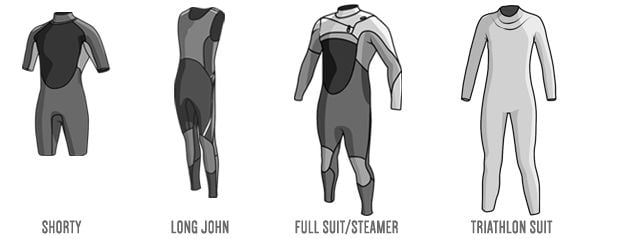Wetsuits
Different Types of Wetsuits: A Complete Guide
Wetsuits are essential for many water sports, providing insulation, protection, and comfort in various water conditions. Whether you’re surfing, diving, swimming, or participating in other water activities, having the right wetsuit can make a significant difference in your performance and enjoyment. Here’s a detailed guide to the different types of wetsuits, their features, and when to use them.
1. Full Wetsuit (Steamer Wetsuit)
A full wetsuit, often called a steamer wetsuit, covers the entire body from neck to ankles and wrists. It’s designed to provide maximum insulation. Making it ideal for colder water temperatures ranging from 10°C to 20°C (50°F to 68°F). Full wetsuits come in various thicknesses, typically ranging from 3mm to 7mm. The thicker the suit, the more warmth it provides.
Key Features:
- Complete Coverage: Protects the torso, arms, and legs, providing overall warmth.
- Thickness Options: Available in various thicknesses to suit different water temperatures.
- Zipper Options: Comes with back zippers, chest zippers, or no zippers for easy entry and minimal water seepage.
Best For:
- Surfing: In cooler waters where. Full-body insulation is required.
- Scuba Diving: To provide warmth and protection against underwater hazards.
- Winter Water Sports: Suitable for cold water swimming, kayaking, and paddleboarding.
2. Spring Suit (Shorty Wetsuit)
A spring suit, also known as a shorty wetsuit, has short sleeves and short legs. This type of wetsuit is ideal for warmer water conditions, typically above 20°C (68°F). Spring suits offer more flexibility and less coverage, making them suitable for summer months or tropical waters.
Key Features:
- Short Sleeves and Legs: Provides freedom of movement while offering some insulation.
- Lightweight: Easier to put on and take off, and less restrictive.
- Versatile: Can be used for a variety of water sports and beach activities.
Best For:
- Surfing in Warmer Waters: Great for spring and summer surfing when full-body coverage isn’t necessary.
- Snorkeling and Swimming: Offers protection from sunburn and jellyfish stings without overheating.
- Recreational Water Sports: Ideal for wakeboarding, jet skiing, and other warm-water activities.
3. Sleeveless Wetsuit (Farmer John/Jane)
The sleeveless wetsuit, often referred to as a “Farmer John” for men or “Farmer Jane” for women, provides coverage for the legs and torso while leaving the arms exposed. This design allows for greater arm mobility, making it a popular choice for activities that require extensive arm movement.
Key Features:
- Sleeveless Design: Allows for increased arm flexibility and freedom of movement.
- Leg Coverage: Provides warmth for the legs while keeping the upper body less restricted.
- Layering: Can be worn with a wetsuit jacket for added warmth.
Best For:
- Paddling and Kayaking: Allows full range of motion for paddling.
- Triathlons: Provides insulation and buoyancy without restricting arm movement.
- Warmer Water Diving: Offers protection and insulation without overheating.
4. Wetsuit Top (Rash Guard with Insulation)
Wetsuit tops, sometimes referred to as insulated rash guards, cover the upper body and are designed for use in warm water conditions. They offer protection against UV rays, minor abrasions, and stings from marine life while providing some thermal insulation.
Key Features:
- Upper Body Coverage: Protects the torso and arms.
- Lightweight Insulation: Offers a thin layer of neoprene for added warmth.
- Versatility: Can be worn alone or layered under a full wetsuit for extra warmth.
Best For:
- Surfing in Warm Climates: Provides sun protection and minimal insulation.
- Snorkeling and Swimming: Protects against the sun and jellyfish stings.
- Layering: Can be used as an additional layer under a wetsuit for extra warmth.
5. Wetsuit Jacket
A wetsuit jacket is similar to a wetsuit top but often thicker and more robust, offering more insulation. It covers the torso and arms and can be paired with board shorts, wetsuit pants, or used alone. Wetsuit jackets are popular for water sports where the water is cool, but a full wetsuit isn’t necessary.
Key Features:
- Upper Body Insulation: Covers the chest and arms for warmth.
- Easy to Put On/Take Off: Usually features front zippers for convenience.
- Layering Option: Can be layered with other wetsuit pieces for customized warmth.
Best For:
- Surfing: In cooler waters where a full suit is too warm.
- Wakeboarding and Windsurfing: Offers upper body protection and warmth.
- Diving: Can be worn over a sleeveless wetsuit or alone in moderately warm waters.
6. Long John/Jane Wetsuit
The long john or long jane wetsuit is a sleeveless design with full leg coverage. This type of wetsuit is popular for activities that require leg protection and flexibility in the arms. It provides a balance of warmth and mobility.
Key Features:
- Full Leg Coverage: Protects against cooler water temperatures and abrasions.
- Sleeveless Design: Allows free arm movement.
- Versatile Use: Suitable for wearing on its own or paired with a wetsuit jacket for added warmth and protection.
Best For:
- Paddleboarding: Provides leg protection without restricting arm movement.
- Warmer Water Diving: Offers a balance of insulation and flexibility.
- Water Skiing: Ideal for protection and warmth without sacrificing arm mobility.
7. Short John/Jane Wetsuit
The short john or jane wetsuit is similar to the long john/jane but with shorter legs, typically ending above the knee. This type of wetsuit is ideal for warm water conditions and offers a good combination of mobility and some degree of insulation.
Key Features:
- Short Legs: Provides freedom of movement for the legs.
- Sleeveless Design: Unrestricted arm mobility.
- Light Insulation: Offers warmth for the core without overheating.
Best For:
- Surfing in Tropical Waters: Offers core warmth while keeping limbs free.
- Warm Weather Triathlons: Ideal for swimming, cycling, and running.
- Kayaking and Canoeing: Provides protection from splashes and sun.
Conclusion
Choosing the right type of wetsuit depends on the water temperature, your activity, and your personal comfort preferences. From full wetsuits that provide maximum insulation to lightweight rash guard tops for sun protection, there’s a wetsuit type for every condition and water sport. Understanding the different types of wetsuits and their features will help you make an informed choice, ensuring you stay warm. comfortable, and protected while enjoying your time in the water.

